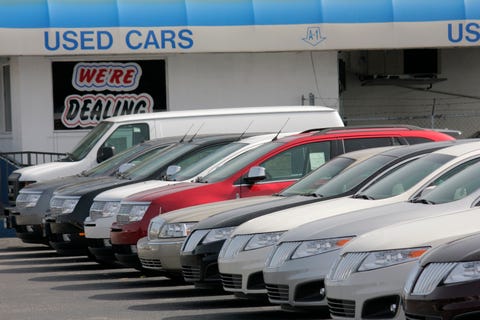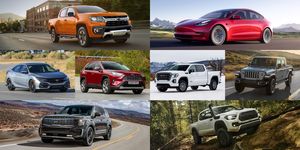- Used car prices have risen dramatically because of a shortage of available new cars and a general increase in car demand.
- Prices are expected to stabilize in the fall, but the computer chip shortage will play a role in the prices normalizing.
- Decreased supply in fleet sales, repossessions, and off-lease cars entering the used market is shrinking the supply.
If you’ve been shopping for a used car lately, you’ve probably been knocked into the Twilight Zone. Used car prices have climbed to unheard of levels, in some cases surpassing the vehicle’s original MSRP, which has effectively turned vehicles into an appreciating asset. This, by and large, is not normal.
“Well, it’s economy 101, supply and demand. We have elevated demand and short supply,” explains Alex Yurchenko, senior vice president of data science for Black Book. “Because of the chip shortage, there’s a shortage of new inventory. We still don’t see it in sales numbers. If you look at May, April, March, they’re healthy 2019 levels—so pre-pandemic. But what’s happening is that dealers are just selling off their inventory. Available inventory is just dropping fast, every single day,” notes Yurchenko. He also explains that available new car inventory is about half of what it was before the pandemic. That’s not good for car shoppers.
Yurchenko expects that the chip shortage will finally start showing up in the sales figures this month. With declining new car availability and no shortage of demand, there’s going to be a continued increase in used car prices. Of course, that’s already happening and is being reflected in their prices.
While it’s easy to point at the computer chip shortage as the problem, that’s only one component of it. Another reason for climbing used car prices is the short supply in that pool, as well. According to Yurchenko, “We still don’t have a lot of repossessions going to market, rental companies that typically sell hundreds of thousands of units a month. Right now they’re not selling anything, because they cannot buy new vehicles…so you have that shortage of used inventory that pushed prices up on the used side.”
Repossessions and fleet cars not reentering the market are having a huge effect on the used car price, but again, they’re not the only reasons for the decreased supply. President of the auction powerhouse ADESA, John Hammer, explains: “When we think about commercial inventory, the main supply channels for that really come from off-lease, repos, rental fleets, and then just other fleet customers. But off-lease cars, we have 80 percent of the supply actually flow through our platform, so we have really good insight into what’s going on the off-lease side. But prices have gone up so much in the market, there’s so much demand for those low-mileage cars, that they’re either getting bought by the customer or getting bought by a dealer before they’re even entering the remarketing channels and have an opportunity to go through the auctions.”
Hammer also touches on some of the supply issues as mentioned by Black Book’s analyst. “All of the stimulus money with government, it’s good for consumers, has really kept those cars out of the lanes. Repo rates are really low. We kind of expected repo rates to spike, but it really hasn’t happened,” says Hammer.
While this increased demand in used cars should increase the price of cars, it’s hard to believe that cars are becoming appreciating assets. “Normally what happens, though, is prices are somewhat capped by new cars,” says Hammer. “So you’ll see used car prices rise and rise, and eventually, they’ll just kind of cap out because they get so close to new car prices that people switch over to buying new cars. But with the new car inventory being so short due to the chip issue, new car prices are rising as well. Our economist tells us ‘it’s the perfect storm meeting the perfect drought.’ There’s a ton of demand and there are just not enough cars out there.”
That explains why these used car prices are rising the way that they are, but how long is this going to happen? According to Yurchenko, we could see things get better as soon as the fall. “In the fall, or close to Q4,” Yurchenko says, “the chip shortage still being the big question mark, but we do expect stabilization in prices.” While that’s good news in the future, Yurchenko does expect used car prices to keep rising in the summer.
Now that we know why we’re seeing the used car market go wild, we should take a look at how it’s actually affecting the movers and shakers—those who are passing those extra costs onto the consumer. The used car dealer is also fighting for inventory, as Hammer explains, “When cars do get in the lane, the dealers are fighting over them. So prices are as high as we’ve seen them. Dealers are shopping further away than they ever did. Bids are up substantially, nearly double per vehicle what we’ve seen in the past… dealers buying out of state is up almost double.”
This narrowing pipeline for inventory is making the dealers work harder for their cars, but that doesn’t mean that dealers are making much less. “Retail prices are much stickier—they don’t change as much,” says Yurchenko. “When the economy shut down last year and wholesale prices dropped by 7-8 percent in April, retail prices did not. The same is true on the opposite side. Right now, wholesale prices are appreciating much, much faster than retail prices. So for dealers, that margin is shrinking fast. Retail prices are increasing, but not at the same speed as wholesale prices.”
Yurchenko also explains that smaller dealers could be making more off wholesale inventory than retail because of the shrinking margins. Bigger dealers? They make up the difference with volume. For example, CarMax reported via email that it sold 100,000 cars in March. A company spokesperson echoed some of the reasons we’ve already outlined about why consumers are moving towards used vehicles, like a shortened supply of new cars and some extra cash. The CarMax spokesperson also mentioned that now is a good time to sell your car. At least, if you don’t need to drive it.
On a first-quarter earnings call, the folks at CarMax are reporting expectedly absurd results. According to the company’s resident and CEO Bill Nash, the folks at CarMax sold 452,000 cars in the first quarter, which surpasses last year’s first-quarter sales by 128 percent. Nash says the company also purchased 236 percent more cars than last year, and 77 percent more than 2019’s first quarter. This all means that CarMax is making the most out of this hot used car market.
This used car bubble won’t last forever, but it seems like it will be on here for a while—at least until the new car market starts to get back on its manufacturing feet. If the market stabilizes in the fall, which is expected, it should make chasing down a used car a little easier. Until then, it looks like you’re going to have to fight to find a deal on a used car.
Are you shopping for a used car? Let us know what your experience in the comments below.




















